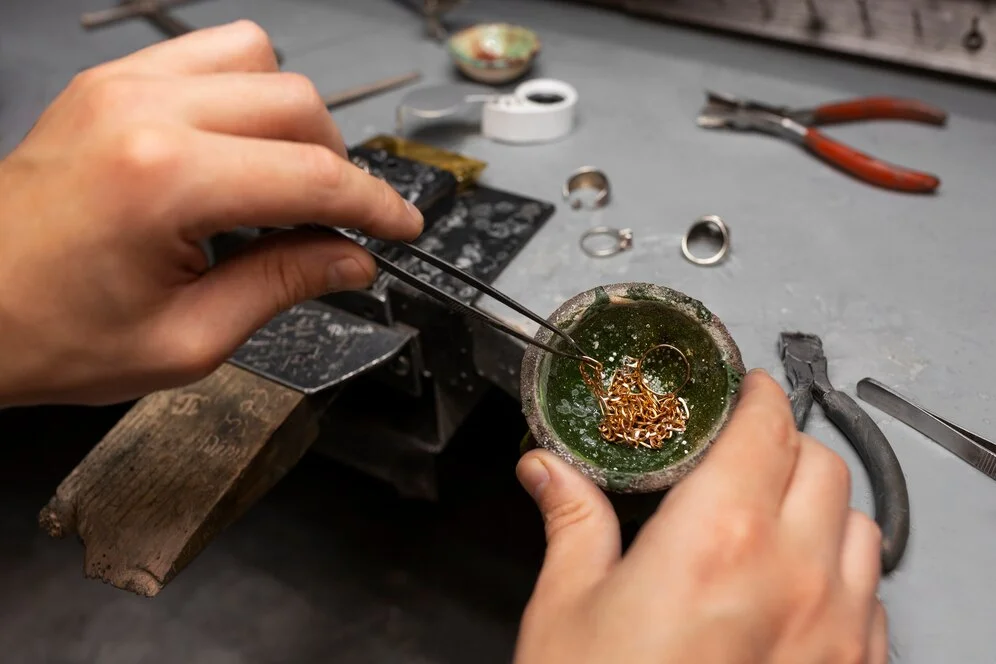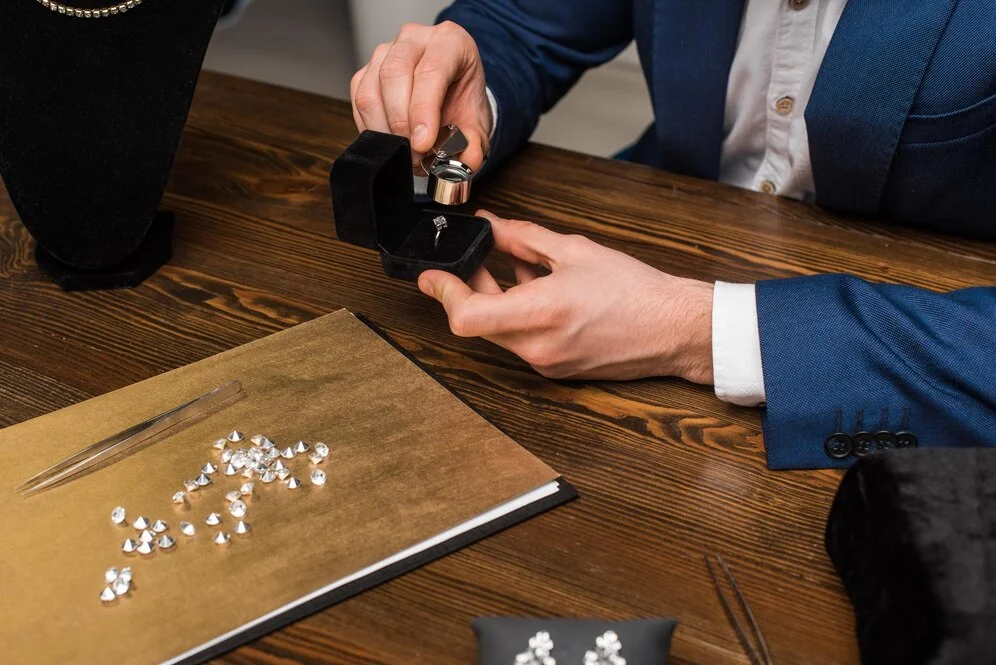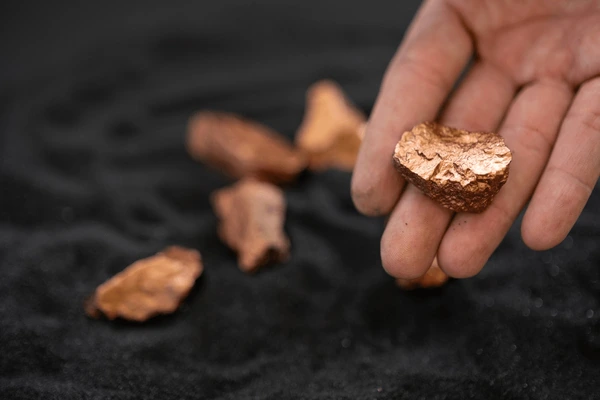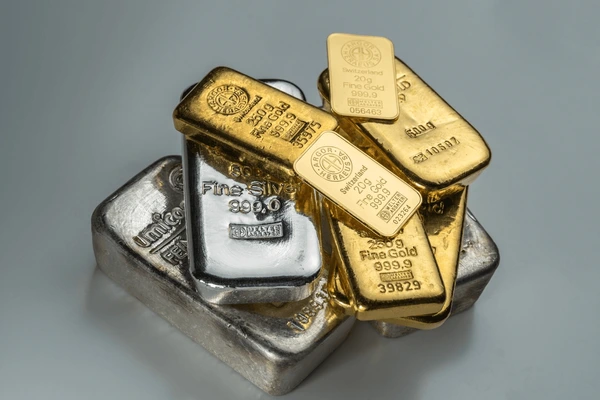Sayanava Sinha Roy
21.04.2025
What Happens During a Jewelry Quality Inspection?
Hello Reader!
Welcome to the blog page of Rahul Refinery, one of the best old gold sellers in Kolkata.
Jewelry Quality Inspection is vital for ensuring the authenticity and craftsmanship of your pieces. Learn how thorough inspections uphold these essential standards.
Table of Contents
Jewelry quality inspections are a crucial step in ensuring that the pieces you buy, sell, or manufacture meet the highest standards. Whether you’re a jewelry manufacturer, a buyer, or a seller, understanding the process of jewelry quality inspection can help you make better decisions and protect your investments. In this article, we will take you through what happens during a jewelry quality inspection and why it’s so important for the industry.

What is Jewelry Quality Inspection?
Jewelry quality inspection refers to a detailed process where the various aspects of a piece of jewelry are evaluated to ensure they meet established standards. The inspection process can take place at different stages of jewelry production or after the jewelry is ready for sale. It involves checking everything from the material quality and design integrity to the craftsmanship and finish.
While many people may think of a jewelry inspection simply as a check for visible flaws, it actually goes much deeper. Inspecting jewelry is about ensuring safety, functionality, and long-term durability. This is why jewelry quality inspection is crucial, not only for jewelry manufacturers but also for buyers seeking to invest in precious pieces.
Key Stages of Jewelry Quality Inspection
There are several stages in a jewelry quality inspection that help determine the overall worth and quality of the jewelry. Here are the key steps involved:
1. Initial Visual Inspection
The first stage of any jewelry quality inspection starts with a thorough visual check. Inspectors look for visible defects such as scratches, dents, cracks, or any irregularities in the design or finish. This is also the stage where inspectors check if the jewelry’s design matches the expected blueprint.
2. Material and Composition Check
Jewelry is often made from precious metals like gold, silver, or platinum. For a piece to be valuable, it’s essential that the materials used are of the highest quality. During this stage, inspectors will verify the material’s authenticity and purity. They may use various methods, such as acid testing or X-ray fluorescence (XRF), to confirm the composition of the metal.
- Gold Purity: A key factor that determines the value of gold jewelry is its purity. Inspectors check if the gold is as pure as claimed, typically through karat testing.
- Gemstones: If the jewelry includes gemstones, they will be inspected for clarity, color, cut, and carat weight. This is a vital step in ensuring that the stones meet the standard for quality.
3. Craftsmanship Evaluation
Good craftsmanship is the hallmark of fine jewelry. During the inspection process, the quality of the craftsmanship is checked by evaluating the construction of the piece. Inspectors will look for things like:
- Setting of Stones: Are the gemstones securely set? A poorly set stone can fall out easily, making the jewelry less valuable.
- Soldering Quality: Inspectors will look for signs of poor soldering or weak joints that may lead to the piece breaking or falling apart.
- Finishing: The finishing process is key to how polished and refined a piece looks. Inspectors will evaluate whether the jewelry has been properly polished or if it’s rough around the edges.
4. Size and Fit Inspection
For jewelry that is made to fit specific sizes, such as rings, bracelets, or necklaces, inspectors will check the measurements. A proper size ensures that the jewelry will fit as expected and be comfortable for the wearer. This is particularly important for custom-made jewelry.
5. Weight Measurement
The weight of a piece of jewelry is often an indicator of its value. Inspectors will carefully measure the weight to make sure it aligns with the specifications, especially for gold or precious metal jewelry. Weighing is also important for ensuring that gemstones are accurately reflected in the overall weight.
6. Certifications and Documentation
In some cases, jewelry quality inspections may also involve checking the authenticity of certificates and documentation, particularly for high-value pieces. This might include certificates of authenticity for gemstones or metal purity certificates, ensuring that the jewelry has been assessed by reputable third parties.

Why is Jewelry Quality Inspection Important?
Jewelry quality inspection plays a vital role in maintaining the value and integrity of the jewelry industry. Here are some key reasons why it’s so important:
- Ensuring Consumer Confidence: Jewelry buyers want to be assured that they’re getting what they pay for. Quality inspections build trust by verifying that the jewelry meets expected standards.
- Protecting Investments: High-quality jewelry can be a valuable investment. A proper inspection helps ensure that the piece retains its value over time and avoids any costly mistakes.
- Regulatory Compliance: In many regions, jewelry sold must meet specific regulatory standards. Inspections ensure that manufacturers are compliant with these regulations, avoiding potential legal issues.
- Reducing the Risk of Fraud: Inspections help prevent the sale of fake or substandard jewelry, reducing the risk of fraud. This is especially important for precious metals and gemstones.
Common Jewelry Quality Inspection Myths
There are many misconceptions about jewelry inspections. Let’s address some common myths:
- Myth 1: Jewelry Inspections Are Only for High-End Pieces.
Jewelry inspections are important for all types of jewelry, not just high-end or luxury pieces. Even affordable jewelry can suffer from poor craftsmanship or subpar materials, so inspections are necessary across the board. - Myth 2: The Quality Inspection Only Checks for Visible Flaws
While visible flaws are an important part of the inspection, the process goes much deeper. Inspectors check material composition, craftsmanship, and overall structure, ensuring that the piece will last and retain its value. - Myth 3: Jewelry Quality Inspections Are Quick and Easy.
A thorough jewelry inspection requires time and attention to detail. Rushing through an inspection may lead to missed flaws or issues that could compromise the piece’s quality.

FAQs About Jewelry Quality Inspection
1. How long does a jewelry quality inspection take?
The time required for an inspection can vary depending on the complexity of the piece. For a basic piece of jewelry, it may take 20 to 30 minutes, while a more intricate design could take several hours to fully inspect.
2. Can I perform my own jewelry inspection?
While you can perform a basic visual check of your jewelry, it’s recommended to have a professional perform a detailed inspection to ensure the piece meets industry standards and retains its value.
3. Do all jewelry inspections include gemstone verification?
Yes, gemstone verification is an essential part of jewelry quality inspection, particularly if the piece contains high-value stones like diamonds or rubies. Inspectors will assess the quality of the stones based on factors like clarity, color, and cut.
Jewelry Quality Inspections: Ensuring Value and Longevity
A Jewelry Quality Inspection is more than just a routine check—it’s a thorough evaluation that ensures your jewelry is crafted from high-quality materials and built to last. Whether you are a buyer, seller, or manufacturer, understanding the inspection process helps you make better-informed decisions and safeguards your investment. By debunking common myths and knowing what to expect during a jewelry inspection, you can be confident that your jewelry will stand the test of time.
If you are looking for the best gold buyer, you can rest assured that thorough inspections will ensure the highest value for your gold jewelry, providing you with peace of mind.
Popular Post



